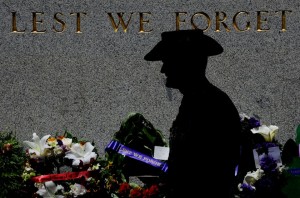 Today is Remembrance Day 11.11.11. and as we take time to remember those who have died or been wounded in all theatres of war this photograph made me think about the families at home. Even with the constant fear for sons, brothers and fathers fighting in foreign lands families still went about their daily routine. This delightful photograph published recently in the Toowoomba Chronicle was taken in 1917 and it shows the Park children, all five of them, Norman, Win, Roy, Rose and Percy on the farm horse‘Old Dandy’ at Greencoe, Pinelands, Queensland.
Today is Remembrance Day 11.11.11. and as we take time to remember those who have died or been wounded in all theatres of war this photograph made me think about the families at home. Even with the constant fear for sons, brothers and fathers fighting in foreign lands families still went about their daily routine. This delightful photograph published recently in the Toowoomba Chronicle was taken in 1917 and it shows the Park children, all five of them, Norman, Win, Roy, Rose and Percy on the farm horse‘Old Dandy’ at Greencoe, Pinelands, Queensland.
Remembrance Day, also known as Poppy Day, Armistice Day or Veterans Day, marks the anniversary of the armistice on 11 November 1918, which led to the end of World War I – the Great War. Remembrance is observed through one minute’s silence at the 11th hour on the 11th day of the 11th month in honour of those who have died or been wounded in all theatres of war.
 The significance of the commemoration throughout allied nations increased in 1920, with the return to Britain of the remains of an unknown soldier. Felled on the battlefields of the Western Front, he was interred with full military honours. At the end of World War II, the Australian government agreed with Britain’s proposal to rename the annual observation Remembrance Day, extending the commemoration to those who have served in all military conflicts. The most notable symbol of Remembrance Day is the red poppy, or Flanders poppy (Papaver rhoeas). It gained resonance for being among the first plants to bloom on the battlefields of northern France and Belgium during the Great War. For soldiers, the red petals represented the blood of their fallen comrades.
The significance of the commemoration throughout allied nations increased in 1920, with the return to Britain of the remains of an unknown soldier. Felled on the battlefields of the Western Front, he was interred with full military honours. At the end of World War II, the Australian government agreed with Britain’s proposal to rename the annual observation Remembrance Day, extending the commemoration to those who have served in all military conflicts. The most notable symbol of Remembrance Day is the red poppy, or Flanders poppy (Papaver rhoeas). It gained resonance for being among the first plants to bloom on the battlefields of northern France and Belgium during the Great War. For soldiers, the red petals represented the blood of their fallen comrades.
What happened in 1917 – Australia
Monarch – King George V
Governor-General – The Right Hon. Sir Ronald Munro-Ferguson
Prime Minister – Billy Hughes
20 March – Lieutenant Frank Hubert McNamara becomes the first Australian airman to receive the Victoria Cross.
5 May – A federal election is held. The incumbent Nationalist government led by Billy Hughes is returned to power.
5 May – Queenslanders reject a referendum to abolish the state’s Legislative Council.[2]
2 August – The General Strike of 1917 begins, a massive industrial action involving over 100,000 workers in support of railway workers in Sydney.
17 October – The two halves of the Trans-Australian Railway meet.
15 November – A general election is held in Victoria. The Commonwealth Liberal Party led by John Bowser defeats the incumbent Labour government led by Sir Alexander Peacock.
29 November – The “Warwick Incident” takes place in the town of Warwick, Queensland. A man throws an egg at Prime Minister Billy Hughes, and the refusal of Queensland Police to arrest him leads to the forming of the Commonwealth Police Force.[3]
12 December – The Royal Australian Navy battlecruiser HMAS Australia is damaged in a collision with the British cruiser HMS Repulse.
20 December – The second plebiscite on the issue of military conscription was held; it was defeated.
Daniel Mannix becomes a Catholic archbishop of Melbourne.
Westcourt wins the Melbourne Cup
The Sheffield Shield was not contested due to the war
Leave a Reply